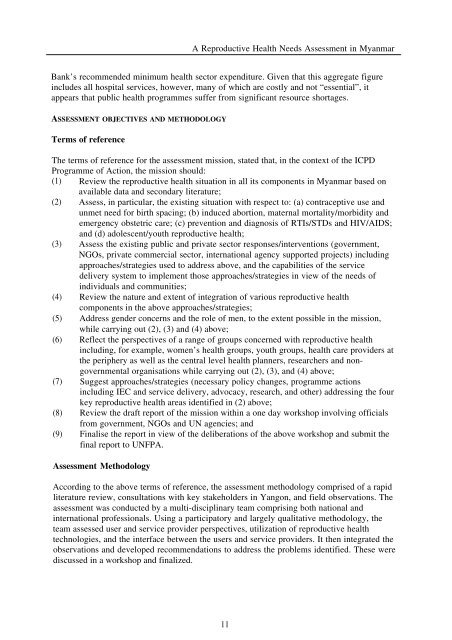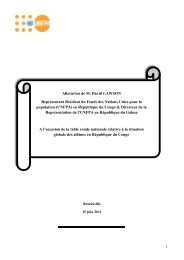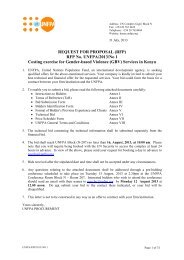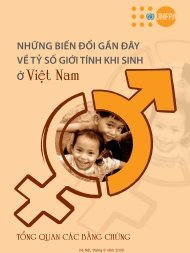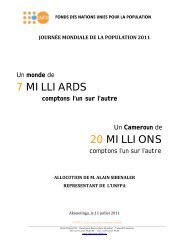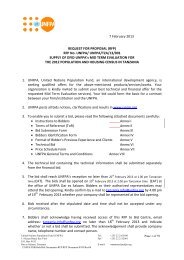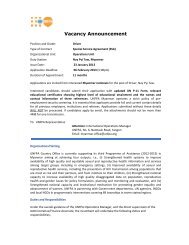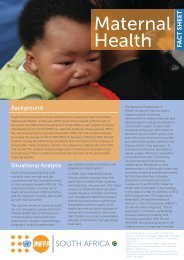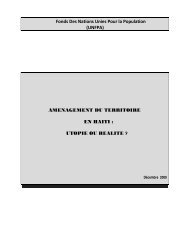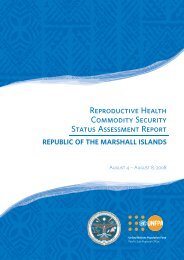A reproductive health needs assessment in Myanmar
A reproductive health needs assessment in Myanmar
A reproductive health needs assessment in Myanmar
Create successful ePaper yourself
Turn your PDF publications into a flip-book with our unique Google optimized e-Paper software.
A Reproductive Health Needs Assessment <strong>in</strong> <strong>Myanmar</strong><br />
Bank’s recommended m<strong>in</strong>imum <strong>health</strong> sector expenditure. Given that this aggregate figure<br />
<strong>in</strong>cludes all hospital services, however, many of which are costly and not “essential”, it<br />
appears that public <strong>health</strong> programmes suffer from significant resource shortages.<br />
ASSESSMENT OBJECTIVES AND METHODOLOGY<br />
Terms of reference<br />
The terms of reference for the <strong>assessment</strong> mission, stated that, <strong>in</strong> the context of the ICPD<br />
Programme of Action, the mission should:<br />
(1) Review the <strong>reproductive</strong> <strong>health</strong> situation <strong>in</strong> all its components <strong>in</strong> <strong>Myanmar</strong> based on<br />
available data and secondary literature;<br />
(2) Assess, <strong>in</strong> particular, the exist<strong>in</strong>g situation with respect to: (a) contraceptive use and<br />
unmet need for birth spac<strong>in</strong>g; (b) <strong>in</strong>duced abortion, maternal mortality/morbidity and<br />
emergency obstetric care; (c) prevention and diagnosis of RTIs/STDs and HIV/AIDS;<br />
and (d) adolescent/youth <strong>reproductive</strong> <strong>health</strong>;<br />
(3) Assess the exist<strong>in</strong>g public and private sector responses/<strong>in</strong>terventions (government,<br />
NGOs, private commercial sector, <strong>in</strong>ternational agency supported projects) <strong>in</strong>clud<strong>in</strong>g<br />
approaches/strategies used to address above, and the capabilities of the service<br />
delivery system to implement those approaches/strategies <strong>in</strong> view of the <strong>needs</strong> of<br />
<strong>in</strong>dividuals and communities;<br />
(4) Review the nature and extent of <strong>in</strong>tegration of various <strong>reproductive</strong> <strong>health</strong><br />
components <strong>in</strong> the above approaches/strategies;<br />
(5) Address gender concerns and the role of men, to the extent possible <strong>in</strong> the mission,<br />
while carry<strong>in</strong>g out (2), (3) and (4) above;<br />
(6) Reflect the perspectives of a range of groups concerned with <strong>reproductive</strong> <strong>health</strong><br />
<strong>in</strong>clud<strong>in</strong>g, for example, women’s <strong>health</strong> groups, youth groups, <strong>health</strong> care providers at<br />
the periphery as well as the central level <strong>health</strong> planners, researchers and nongovernmental<br />
organisations while carry<strong>in</strong>g out (2), (3), and (4) above;<br />
(7) Suggest approaches/strategies (necessary policy changes, programme actions<br />
<strong>in</strong>clud<strong>in</strong>g IEC and service delivery, advocacy, research, and other) address<strong>in</strong>g the four<br />
key <strong>reproductive</strong> <strong>health</strong> areas identified <strong>in</strong> (2) above;<br />
(8) Review the draft report of the mission with<strong>in</strong> a one day workshop <strong>in</strong>volv<strong>in</strong>g officials<br />
from government, NGOs and UN agencies; and<br />
(9) F<strong>in</strong>alise the report <strong>in</strong> view of the deliberations of the above workshop and submit the<br />
f<strong>in</strong>al report to UNFPA.<br />
Assessment Methodology<br />
Accord<strong>in</strong>g to the above terms of reference, the <strong>assessment</strong> methodology comprised of a rapid<br />
literature review, consultations with key stakeholders <strong>in</strong> Yangon, and field observations. The<br />
<strong>assessment</strong> was conducted by a multi-discipl<strong>in</strong>ary team compris<strong>in</strong>g both national and<br />
<strong>in</strong>ternational professionals. Us<strong>in</strong>g a participatory and largely qualitative methodology, the<br />
team assessed user and service provider perspectives, utilization of <strong>reproductive</strong> <strong>health</strong><br />
technologies, and the <strong>in</strong>terface between the users and service providers. It then <strong>in</strong>tegrated the<br />
observations and developed recommendations to address the problems identified. These were<br />
discussed <strong>in</strong> a workshop and f<strong>in</strong>alized.<br />
11


